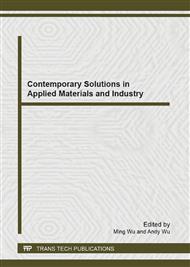p.597
p.602
p.606
p.611
p.614
p.617
p.620
p.624
p.633
Effects of Sufentanil Preconditioning on Myocardial Infarction Areas and the Myocardial Enzyme in Myocardial Ischemia- Reperfusion Injury in Rats In Vivo
Abstract:
Objective.To investigate the effects of sufentanil preconditioning on Myocardial ischemia reperfusion injury in rats in vivo.Methods. To randomly divide 50 male SD rats equally into 5 groups, including ischemia-reperfusion group( Group I/R ), ischemic preconditioning group(Group IPC), high-dose sufentanil preconditioning group(Group HS, 6.0µg/kg), medium-dose sufentanil preconditioning group(Group MS,2.0µg/kg) and low-dose sufentanil preconditioning group(Group LS, 0.60µg/kg).The left anterior descending coronary arterys(LAD) of rats in five groups are ligated for 30 minutes and are re-perfused for 90 minutes. To measure the myocardial infarction size (IS/AAR%) with double-staining with Even's blue and triphenyltetrazolium chloride, and to calculate the concentration of LK, LK-MB and LDH. Result. Comparing with Group 1/R , the myocardial infarction size(IS/AAR%) in Group IPC, HS, MS and LS all reduced at different levels. Among the Group HS, MS and LS, the infarction size in Group HS reduced most significantly. Comparing with Group 1/R, the concentration of the serum myocardial enzymes in the other four groups all reduced at different levels. Conclusion. Sufentanil preconditioning can reduce myocardial infarct size, decrease the concentration of the serum myocardial enzymes. Therefore, sufentanil preconditioning has protective effects on myocardial ischemia-reperfusion injury in rats in vivo, and the effects are dose-dependent. Suffentanil is a potent kind of opioid analgesics, which is widely used in clinical anesthesia. However, further studies are needed on effects of sufentanil preconditioning on myocardial ischemia reperfusion injury. In order to protect the Myocardial ischemia patients and provide the foundations for application of sufentanil in peri-operative period, the authors investigate the effects of sufentanil preconditioning on myocardial ischemia reperfusion injury through comparison and analysis of the myocardial infarction size(IS), the concentration of the serum myocardial enzymes in the ischemia-reperfusion group(Group IPC), the ischemic preconditioning group(Group IPC) and different-dose sufentanil preconditioning group(Group HS, MS LS).
Info:
Periodical:
Pages:
614-616
Citation:
Online since:
April 2013
Authors:
Price:
Сopyright:
© 2013 Trans Tech Publications Ltd. All Rights Reserved
Share:
Citation:


